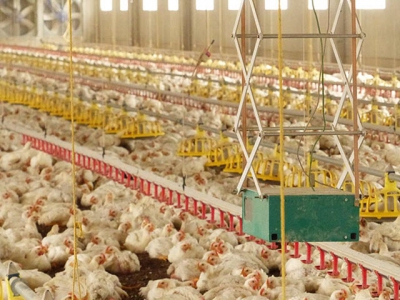Poultry farming: The robots are coming

Predictions are that robots in poultry houses will soon surveil grow-out conditions and perform interactive tasks all around the industry.
The ChickenBoy robot runs through the house on a track attached to the ceiling at a speed that does not scare the birds. | Photo by Benjamín Ruiz
Robotic technologies to be presented at the Poultry Tech Summit give a glimpse into the next revolution in poultry farming — automation that tirelessly interacts with flocks, pinpoints localized problems in the house and reports everything on the cloud.
These in-house robots include two models at the Poultry Tech Summit that offer new approaches for improving poultry welfare and performance while reducing labor needs.
- Colin Usher with the Georgia Tech Research Institute will share details of a poultry house robot that operates on the floor of the house and navigates using imaging sensors and can detect and pick up floor eggs.
- Heiner Lehr with Farm Robotics and Automation SL will present a poultry house robot that is suspended from the ceiling of the house and has sensors for monitoring both bird and house conditions.
Gohbot navigates with AI and sensors
Gohbot is an automated mobile robot capable of navigating intelligently in a commercial poultry house to interact with the birds and carry out utility tasks such as the automatic removal of floor eggs. It uses artificial intelligence routines and a suite of sensors, including 2D and 3D imagers, in combination with infrastructure to navigate inside commercial chicken houses. AI routines allow for characterizing chickens, equipment and locating eggs on the floor.
“We envision a robot that ‘lives’ in the poultry housing facilities and works around the clock both evaluating the status of the flocks and removing floor eggs and/or mortality,” said the developers at GTRI.
ChickenBoy makes data accessible
The ceiling-mounted ChickenBoy autonomous robot runs on simple rails through the chicken house to monitor management issues, including the detection of health issues, localization of dead birds, detection of bedding problems and measurement of ambient conditions.
Users access dashboards with this information through a cloud-based platform:
- Farmers use the information to improve animal welfare and productivity.
- Vertically integrated companies are able to better monitor growing conditions.
- Veterinarians and consultants improve their services with more and faster data from farms.
- Researchers and product developers access data to test and develop new sensors and algorithms in third-party extension modules.
The company is working to develop the mechanical removal of dead birds.
Robots are coming to poultry farms
“Robotics for poultry farms is really new. There are no significant numbers of farms using robots today. We are talking about a total of perhaps 20 to 30 farms,” said Lehr.
Usher said, “There are very few current robot systems in this field, simply due to the technology being so new and in some cases too expensive for farmers to purchase.”
Lehr and Usher both foresee rapid and significant adoption of in-house robotics over the next seven years.
“By 2025, we envision quite a different picture, Lehr said. “We estimate that at least the top 20 percent to 30 percent of farms will be operating with robots. If the trend of vertical integration further increases, then that number might easily be higher.”
Usher thinks the adoption of on-farm robotics could be more rapid if larger poultry integrators get on board. “We think that by 2025, the majority of the forward thinking smaller producers will adopt the technology, leading to around 20 percent to 25 percent of farms utilizing a robot. If the larger vertically integrated companies mandate the use of robots, this number could jump to between 50 percent and 75 percent of all poultry farms,” he said.
How and where farm robots will be used
Lehr predicted that in the future robots on farm will perform diverse tasks:
- Observe chickens and provide advice to farmers for best rearing
- Determine most or all of the key performance indicators on the farm
- Collect stray eggs and dead birds and perhaps even bring severely ill birds to a hospital area on the farm
- Contribute to intelligent, individualized and fully automatic management of climate, water and feed
Usher said there has been strong interest in the robots' capabilities from all corners of the poultry farming industry. “It is our opinion,” he said, “that the cage-free layer and breeder houses will be first to adopt the technology due to benefits a robot can bring such as automated floor-egg removal. Broiler production houses may be later to adopt the technology.”
“I believe that after 10 to 20 years perhaps close to 90 percent of the farming industry will utilize robotics,” Usher predicted. Why not sooner? “I think the technology is very new and still has to be introduced and proven to gain traction in the industry.”
More robotics and automation at Poultry Tech Summit
More robotics and automation to be presented at the Poultry Tech Summit bring new solutions to poultry processing and further processing:
- Seung-Chul Yoon with USDA ARS will present a machine vision system for detecting woody breast in boneless skinless breast filets without contacting or damaging the filets.
- Sim Harbart with The Georgia Tech Research Institute will present a virtual reality system that simulates cutting trajectories for automated poultry processing systems.
Có thể bạn quan tâm
 Recruiting the next generation of poultry professionals
Recruiting the next generation of poultry professionals The US Poultry & Egg Association is sponsoring programs to teach young people about the poultry industry and hopefully increase interest in working in the field
 Chicken gene edit prevents avian flu virus spread
Chicken gene edit prevents avian flu virus spread In laboratory-grown chicken cells, deleting section of DNA prevented avian flu virus from spreading.
 Understanding of chicken's environmental impact examined
Understanding of chicken's environmental impact examined National Chicken Council seeks to bridge gap between consumer perception and reality.